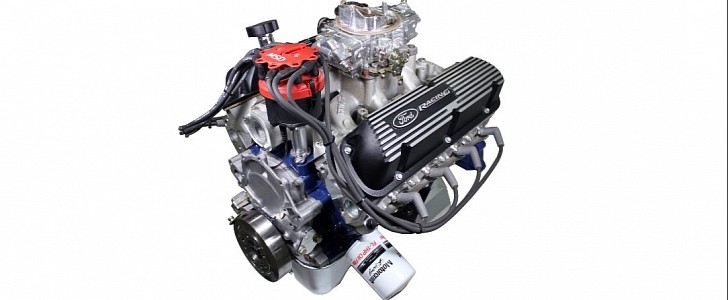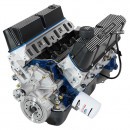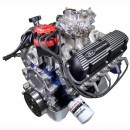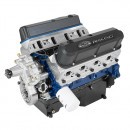A gentleman by the name of George Stirrat and eight of his colleagues started the development of the Ford small block in 1960. This group of engineers – internally referred to as Canadian X Project – was tasked with creating a compact, light, and robust powerplant that could be increased in displacement as needed. The successor of the Y-block engine started production in 1961, and the final example rolled off the line in 2000.
Before going over the 302-based V8 crate engines available to purchase at press time on Ford Performance, we should remind ourselves why the 302 is the most revered small block produced by the Dearborn-based company. First things first, let us continue the history lesson with the 221-ci (3.6-liter) variant of this iconic mill. The 1962 model year Ford Fairlane and Mercury Meteor were the first production cars to receive the cast-iron powerplant, marketed as the Fairlane V8, with 145 hp and 216 lb-ft (293 Nm) on deck.
Not even three months after the start of production, the 260-ci (4.3-liter) Challenger was introduced with a larger bore and a slightly higher compression ratio. Carroll Shelby immediately recognized the go-faster potential of this lump, shoehorning the 260 in the AC Cobra. The 289-ci (4.7-liter) variant was introduced in 1963, then FoMoCo launched the 302 to much critical acclaim. Actually a 4.9 despite the 5.0 moniker that rolled out in 1978, this engine powered the GT40 of Pedro Rodriguez and Lucien Bianchi to victory at the 1968 edition of the grueling 24 Hours of Le Mans.
The 302 did have a low point, though. The Malaise Era saw the Five-Oh engine drop to a dismal 122 ponies due to emission regulations, the switch to net ratings, and the Nixon Administration’s push to phase out leaded gasoline. Before the mass adoption of fuel injection in the 1980s, net ratings didn’t exceed 210 horsepower. Before sequential multi-port fuel injection became a thing, the 302 was briefly treated to throttle-body fuel injection.
A mainstay through the late 1990s, the 302 is often referred to as the Windsor because it was manufactured in Windsor. Be that as it may, it shouldn’t be confused with the 351W. Also worthy of note, the 335-based 351C (a.k.a. the Cleveland) is different from the small block-based 351W. Progressively replaced by the 4.6-liter V8 from the Modular engine family, the 302 saw its final applications in the Aussie-spec Falcon and Fairlane.
No fewer than five 302-based small blocks are currently available as crate engines. The Ford Performance part numbers for these lumps are M-6007-X2302E, M-6007-X2347DF, M-6007-X2347DR, M-6007-Z2363FT, and M-6007-Z2363RT. Funnily enough, only the M-6007-X2302E displaces 302 ci. Priced at $10,995, this powerplant carries the X2 prefix and E suffix to designate the aluminum cylinder heads and hydraulic roller camshaft.
Rated at 340 hp and 330 lb-ft (447 Nm), the naturally-aspirated V8 rocks a Boss four-bolt main block and a double roller timing chain set. Gifted with a forged crank, forged conrods, forged pistons, and a 9.0:1 compression ratio, this crate engine develops the aforementioned output numbers with an Edelbrock Performer RPM Air-Gap intake and 570-cfm carburetor that need to be purchased separately. The M-6007-X2302E doesn’t include a distributor either. Ford Performance recommends MSD part number M8598.
M-6007-X2347DF is a 347-ci (5.7-liter) variant, just like M-6007-X2347DR. The main difference between these 302-based crate engines is the oiling system: front sump pan for the DF and rear sump pan for the DR. Think of the 347 as an alternative to the 350 from the biggest of the Big Three in Detroit. The 350 can be had with 385 hp and 405 lb-ft (549 Nm) in SP350/385 format, whereas FoMoCo’s 347 belts out 360 hp and 400 lb-ft (542 Nm).
As opposed to the 302, the 347 flaunts a 9.6:1 compression ratio and comes in the guise of a dressed engine rather than a long block (a.k.a. partly assembled engine that consists of quintessential bits such as the short block, crank, cylinder heads, cam, and valvetrain). Priced at $13,450, the 347 is bored .030 over. Equipped with a streetable camshaft whose intake and exhaust lobes have fast-opening ramps to keep port velocity high, this V8 idles at merely 800 revolutions per minute and pulls 19 inches of vacuum.
Capable of spinning to 6,000 rpm, the DF and DR feature SCAT forged I-beam connection roads, Mahle forged pistons with floating wrist pins, a Holley Street Avenger 570-cfm carb, black aluminum valve covers, a billet distributor from MSD, black spark plug wires, a Comp Cams camshaft, and the 1-3-7-2-6-5-4-8 firing order the 347 shares with the 5.0L HO and the 351W. An Edelbrock intake manifold completes the street-tuned package.
The final entries come in the form of the M-6007-Z2363FT and M-6007-Z2363RT. The 363-ci (5.9-liter) V8 is the hottest Ford stroker around. The larger bores add up to more intake airflow, which means bigger bangs, which leads to increased horsepower and torque. Ford Performance quotes 507 hp at 6,500 rpm and a very stirring 450 lb-ft (610 Nm) at 5,100 rpm.
The bore and stroke on the 363 are 4.125 and 3.400, and similar to the 347, this bad boy is equipped with I-beam connecting rods. Spruced up with ARP bolts, the largest 302-based small block delivers both street and strip performance thanks to Z2 cylinder heads. According to Ford, the Velocity Vane intake port design of the Z2 is worth 3 and 7 horsepower from 4,500 through 6,500 rpm compared to the same port without the vane.
Thanks to the 8.200-inch deck height, the $14,250 363 will fit pretty much any engine bay that originally accommodated the 289 or 302. Revised cooling passages also need to be mentioned, along with PAC 1219X Ovate Beehive conical valve springs, an Edelbrock water pump, and a 10.2:1 compression ratio. All of these 302-based crate engines require premium unleaded gasoline, and all five are intended for competition or off-highway use.
Not even three months after the start of production, the 260-ci (4.3-liter) Challenger was introduced with a larger bore and a slightly higher compression ratio. Carroll Shelby immediately recognized the go-faster potential of this lump, shoehorning the 260 in the AC Cobra. The 289-ci (4.7-liter) variant was introduced in 1963, then FoMoCo launched the 302 to much critical acclaim. Actually a 4.9 despite the 5.0 moniker that rolled out in 1978, this engine powered the GT40 of Pedro Rodriguez and Lucien Bianchi to victory at the 1968 edition of the grueling 24 Hours of Le Mans.
The 302 did have a low point, though. The Malaise Era saw the Five-Oh engine drop to a dismal 122 ponies due to emission regulations, the switch to net ratings, and the Nixon Administration’s push to phase out leaded gasoline. Before the mass adoption of fuel injection in the 1980s, net ratings didn’t exceed 210 horsepower. Before sequential multi-port fuel injection became a thing, the 302 was briefly treated to throttle-body fuel injection.
A mainstay through the late 1990s, the 302 is often referred to as the Windsor because it was manufactured in Windsor. Be that as it may, it shouldn’t be confused with the 351W. Also worthy of note, the 335-based 351C (a.k.a. the Cleveland) is different from the small block-based 351W. Progressively replaced by the 4.6-liter V8 from the Modular engine family, the 302 saw its final applications in the Aussie-spec Falcon and Fairlane.
Rated at 340 hp and 330 lb-ft (447 Nm), the naturally-aspirated V8 rocks a Boss four-bolt main block and a double roller timing chain set. Gifted with a forged crank, forged conrods, forged pistons, and a 9.0:1 compression ratio, this crate engine develops the aforementioned output numbers with an Edelbrock Performer RPM Air-Gap intake and 570-cfm carburetor that need to be purchased separately. The M-6007-X2302E doesn’t include a distributor either. Ford Performance recommends MSD part number M8598.
M-6007-X2347DF is a 347-ci (5.7-liter) variant, just like M-6007-X2347DR. The main difference between these 302-based crate engines is the oiling system: front sump pan for the DF and rear sump pan for the DR. Think of the 347 as an alternative to the 350 from the biggest of the Big Three in Detroit. The 350 can be had with 385 hp and 405 lb-ft (549 Nm) in SP350/385 format, whereas FoMoCo’s 347 belts out 360 hp and 400 lb-ft (542 Nm).
As opposed to the 302, the 347 flaunts a 9.6:1 compression ratio and comes in the guise of a dressed engine rather than a long block (a.k.a. partly assembled engine that consists of quintessential bits such as the short block, crank, cylinder heads, cam, and valvetrain). Priced at $13,450, the 347 is bored .030 over. Equipped with a streetable camshaft whose intake and exhaust lobes have fast-opening ramps to keep port velocity high, this V8 idles at merely 800 revolutions per minute and pulls 19 inches of vacuum.
The final entries come in the form of the M-6007-Z2363FT and M-6007-Z2363RT. The 363-ci (5.9-liter) V8 is the hottest Ford stroker around. The larger bores add up to more intake airflow, which means bigger bangs, which leads to increased horsepower and torque. Ford Performance quotes 507 hp at 6,500 rpm and a very stirring 450 lb-ft (610 Nm) at 5,100 rpm.
The bore and stroke on the 363 are 4.125 and 3.400, and similar to the 347, this bad boy is equipped with I-beam connecting rods. Spruced up with ARP bolts, the largest 302-based small block delivers both street and strip performance thanks to Z2 cylinder heads. According to Ford, the Velocity Vane intake port design of the Z2 is worth 3 and 7 horsepower from 4,500 through 6,500 rpm compared to the same port without the vane.
Thanks to the 8.200-inch deck height, the $14,250 363 will fit pretty much any engine bay that originally accommodated the 289 or 302. Revised cooling passages also need to be mentioned, along with PAC 1219X Ovate Beehive conical valve springs, an Edelbrock water pump, and a 10.2:1 compression ratio. All of these 302-based crate engines require premium unleaded gasoline, and all five are intended for competition or off-highway use.








